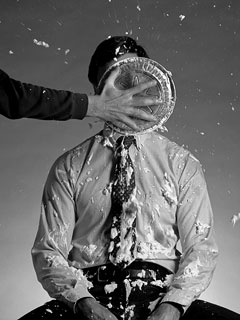


Confused About Steel Shot and Barrel Damage?

Apparently,
many people are. Steel shot certainly can damage forcing cones and chokes.
In fact, it says so right on the box of most steel shotshell loads. It
is hard to miss. You use steel shot at your own risk, and while thicker
plastic shot cups are designed to lessen or minimize the damage in modern
shotshell barrels, they are not represented as guaranteed to do so and
the shotshell manufacturers accept no responsibility for any damage to
your barrel. They tell you this on every box, yet still some ask if steel
can damage a shotgun barrel. Of course it can. If we don't understand
the problems associated with steel, all we have to do is read Lyman's
Shotshell Reloading Handbook, 4th Ed., Chapter 20. It is common knowledge,
unless you've never heard of Lyman Ballistic Laboratories.
It goes back to the way shotguns are designed in the first place. They are not designed to be particularly strong. Shotguns are low pressure applications, MAP roughly half of .22 rimfires, and they aren't supposed to be strong. They are large diameter barrels designed with minimum, but appropriate barrel walls. Sure, they could be stronger, but few want to lug around twenty pounds of lifeless pipe all day. It would be stronger, of course, but both unpleasant and unacceptable.
While SAAMI specifications are completely voluntary, CIP regulations are not. To lessen the possibility of barrel damage, the CIP looks closely at steel loads. CIP sets a maximum velocity for each of the steel shot levels; 400 m/s (1,312 f/s) for Standard Steel Shot, and 430 m/s (1,410 f/s) for High Performance Steel Shot. CIP sets limits on maximum shot size. SAAMI has no limits on shot size. CIP sets limits on maximum momentum. SAAMI has no limits on momentum. CIP sets a maximum choke constriction of 0.5mm (0.0195 inch) for High Performance Steel only.
The CIP does this to limit the possibility of firearm and firearm barrel damage. If you think that keeping steel shells to 1410 fps or below and using about a 20 thousandths constriction choke or less helps protect your barrel from damage, that's exactly why the CIP has these standards. They aren't random musings at all, but strictly designed to lessen barrel damage. We have this idea that shotgun barrels are supposed to last forever. Certainly, they can last a good long time with lead shot. Consider the life of a rifle barrel. A thousand rounds to some benchrest shooters, it is new barrel time. One of the many issues with choke constriction is that unless you mic both an individual shotgun's bore and your choke, you have no clue what the constriction actually is.
There are better shot materials in terms of external ballistics and wounding ballistics than steel, there always has been. It is called lead. Beyond that, you have Nice Shot and Kent Tungsten-Matrix shells that are just as easy on your barrel as lead, and offer greater range and better terminal performance than steel as well: about 25% more range, according to Lyman Ballistic Labs. A small price to pay to protect a shotgun that you treasure and cleaner kills are always a good thing.

Oh no, a scratched up and scored barrel? Well, we asked for it.
Alright, but suppose we are cheap (my Dad calls it “conservative”) and we want the cheapest thing that goes bang. Besides, our buddy Waldo has put eight million steel shells through his gun and says there is no damage. Waldo isn't a metallurgist, he isn't a gun designer, he doesn't manufacture chokes, and Waldo isn't going to buy you a replacement barrel. So, you can listen to Waldo, the fine fellow that he is, or actually read the printed caution on your box of steel shotshells that tells you the shells may indeed damage your barrel and the shotshell manufacturer accepts no responsibility for it.
Certainly, steel shot is the choice of some dentists, if not the lumber industry. If there is a bright side, it is that the barrel damage created by steel is largely cosmetic. Damaged forcing cones, scratched barrels, and swelled barrels may still pattern acceptably. Pitted rifle barrels may still be accurate, for that matter. But, if you don't like damage potential to your barrels, again-- Kent Tungsten-Matrix and Nice Shot eliminate that potential. I've damaged a few "steel compatible" barrels with steel shot and I recently discussed it with a friend who used steel shot in his so-called "steel proof" 10 gauge. Now, he has visible .020 inch bulges in front of the choke area and he isn't what I would call pleased.
Smaller diameter steel shot (not letter sized) and moderate muzzle velocities help mitigate or at least slow down the rate of damage. Things like mylar wraps and generous over-shot wads make for better shells, but that adds substantial cost. It is never a good idea to have a pellet harder than a barrel to come in contact with a barrel. Mylar wraps are not used (they should be) simply because it cannot be done with high-speed factory machinery. It is anyone's choice, of course, and there is no guarantee of barrel scoring just like there is no guarantee of no barrel damage. Just like “when all else fails, read the instructions” it isn't a bad idea to consult the cautions and warnings printed on your shotshells from time to time. Ammo companies might hate to say, “I told you so,” but in this case they clearly have.
Copyright 2012 by Randy Wakeman. All Rights Reserved.

Custom Search

Custom Search



